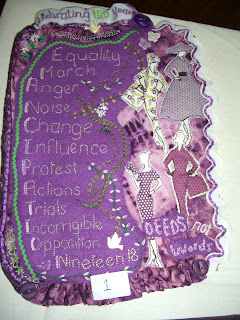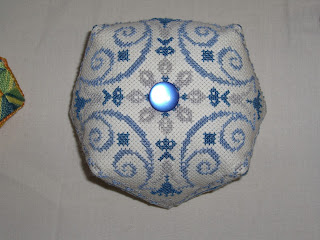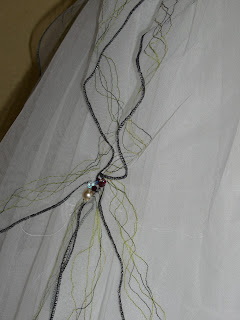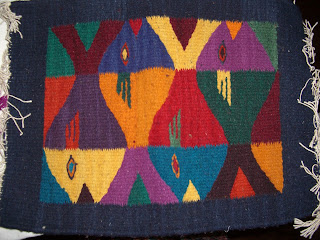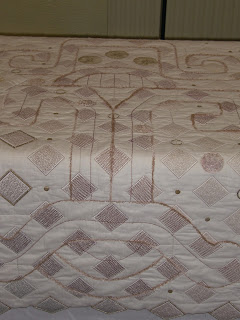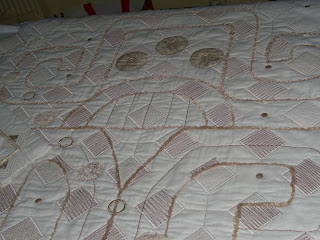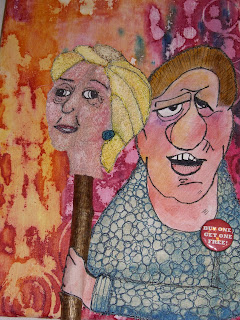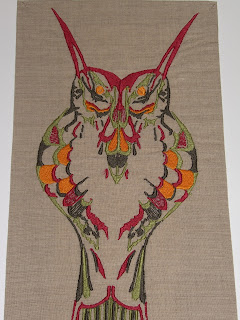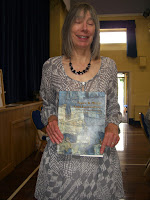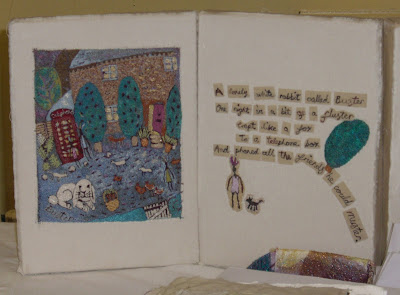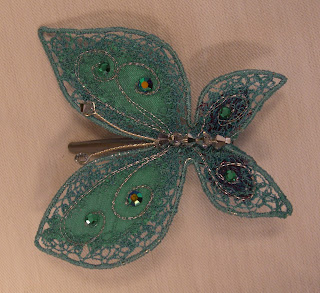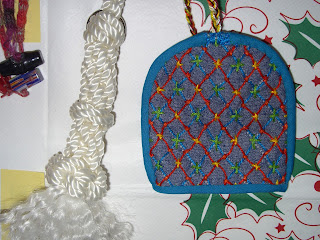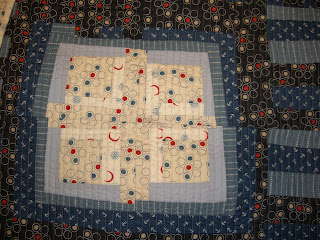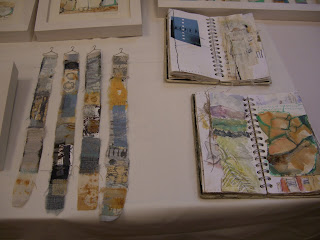16th May meeting
 "My Life in Embroidery'' - Brenda Scarman
brought examples of her work to illustrate her journey including her
life changing health event. She explained what she was doing including
how she was now compiling her work into books with the relevant
explanations, sketches and designs.
"My Life in Embroidery'' - Brenda Scarman
brought examples of her work to illustrate her journey including her
life changing health event. She explained what she was doing including
how she was now compiling her work into books with the relevant
explanations, sketches and designs.
18th April meeting
 "My Life in Embroidery'' - Brenda Scarman
brought examples of her work to illustrate her journey including her
life changing health event. She explained what she was doing including
how she was now compiling her work into books with the relevant
explanations, sketches and designs.
"My Life in Embroidery'' - Brenda Scarman
brought examples of her work to illustrate her journey including her
life changing health event. She explained what she was doing including
how she was now compiling her work into books with the relevant
explanations, sketches and designs.17th May - workshop ''Teacup Trees'' with Jane Fairweather
18th April meeting
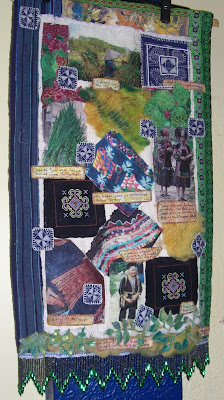 Vietnamese
and Cambodian Textiles - Mary Hart brought examples of textiles sourced
from her travels together with pieces of her work.
Vietnamese
and Cambodian Textiles - Mary Hart brought examples of textiles sourced
from her travels together with pieces of her work.

17th January 2019
Members meeting
Started with welcome and notices, then members grouped themselves according to which of the banner projects they selected.
 The 'Connected Threads Letters' co ordinated by Marjorie
The 'Connected Threads Letters' co ordinated by Marjorie
The 'New Banner' using artist canvases co ordinated by Carrie
social /create a keyring.

 The 'Connected Threads Letters' co ordinated by Marjorie
The 'Connected Threads Letters' co ordinated by MarjorieThe 'New Banner' using artist canvases co ordinated by Carrie
social /create a keyring.


There was also the opportunity to participate in the raffle , make purchases at the sales table or the 'Audlem charity shop' stall, sign up for workshops or borrow copies of Stitch magazine.


20th September 2018
AGM – following the business
The surprise speaker at the meeting was Evie Astbury –Field
from the RSPCA Stapeley Grange with her interesting and informative
presentation about Hedgehogs.
There were displays of the 2018 travelling books
also
the many different creative pieces submitted for the Chairman’s Challenge’ which
were voted on by members




The prize of EG membership for 2018 -19 being
awarded to Val Williams.
The Connected Threads Stitch Group Exhibition pieces were on display and much admired.
Also some of the lampshades made at the two day workshop held in July
There were many winners of the raffle prizes





The meeting ended with tea/coffee and a varied selection of lovely cakes.
15th February 2018
My Blue Suitcase by Amanda Clayton
7th December 2017
Christmas Lunch this year had a change of venue to Audlem Public Hall with caterers due to the closure of Brookfield Golf Club.


We had our normal 'swap' which this year was a pin cushion for which we had 28 very varied entries, a draw for the table decoration and a felt christmas decoration(a star, holly leaves or a christmas tree all enhanced with stitch,buttons or beads).


 The surprise speaker was Alison Cooper a floral artist who created some spectacular arrangements, which she made look very simple and easy to construct, giving us inspiration for our festive decorations. The floral arrangements were won by several lucky ticket holders- drawn at the end of the lunch.
The surprise speaker was Alison Cooper a floral artist who created some spectacular arrangements, which she made look very simple and easy to construct, giving us inspiration for our festive decorations. The floral arrangements were won by several lucky ticket holders- drawn at the end of the lunch.
16th November 2017
'The Corset Unlaced' by Gill Roberts
Gill has been an embroiderer from the age of 5, but only started her business 'Belladonna and Roses' in corsetry five years ago. Following cancer, which showed her that life was too short not to follow your interests, Gill gave up accountancy and started her own business making use of her previous work for special occasions and embroidery.
The talk was interesting and informative covering the history of corsetry from its beginings in the 1500's through its various forms and changes due to fashions/developments of materials etc to the present day when corsets are decorative.
Gill brought many wonderful examples of her work with her to illustrate the presentation.
The talk was interesting and informative covering the history of corsetry from its beginings in the 1500's through its various forms and changes due to fashions/developments of materials etc to the present day when corsets are decorative.
Gill brought many wonderful examples of her work with her to illustrate the presentation.
15th June 2017
Travels in Mexico and Guatemala by Pauline Barnes
Following a City and Guilds patchwork and quilting course
instead of continuing on to part 2 Pauline undertook a 3 year design course. For
this she was able to use the photographs taken during her travels in Mexico as
inspiration for her subsequent work.

 The images of the Mayan temples, carvings
on stones, the ‘Pyramid of the Wizard’, the ‘X’ an ancient symbol in the
culture and also ‘Chaac’ the rain god which features on many of the buildings.
The images of the Mayan temples, carvings
on stones, the ‘Pyramid of the Wizard’, the ‘X’ an ancient symbol in the
culture and also ‘Chaac’ the rain god which features on many of the buildings.  Pauline also brought back a selection of textile items which attracted her and are useful sources of ideas.
Pauline also brought back a selection of textile items which attracted her and are useful sources of ideas. Pauline used her quilting background and incorporated many of the features which she explored in her design work in their creation. During her experimentation she found that dying the cream fabric she uses did not produce the required results and so explored using coloured threads and stitch to create the desired effects.
The quilt ‘Transforming Tradition’ took about 300 hours to produce and features the Mayan ‘X’ Motif.
18th May 2017
My Creative Journey by Judith Rowley
As a child Judith was always making things and drawing, her
father was a design/graphic engineer all of which led to her taking Art at both
‘O’ and ‘A’ level . She then trained to teach and was able to introduce both
art and stitch into her teaching.
In 2005 Judith finished teaching and went to
college to take C and G and also a diploma in Stitch and Textiles. Whilst
working through this she completed all the tasks but found there were some she
enjoyed and others like ‘Blackwork’ which she disliked. Having identified the
aspects which she preferred and being conscious of requiring a ‘style’ for her
work Judith set about thinking.
 Fortunately 3 things happened to provide a
solution; firstly her son returned home wearing jeans in urgent need of repair and
Judith suggested darning them (rather like weaving which she had liked),
secondly she visited the ‘Whitworth Art Gallery’ and was drawn to a model of a
child wearing a garment made in 2000BC which was largely darns i.e. horizontal
and vertical lines, the third event was a dream where she saw her work in the ‘Birmingham City
Art Gallery’ with the work comprising of intersecting lines. This was to become
Judith’s style for all future projects.
Fortunately 3 things happened to provide a
solution; firstly her son returned home wearing jeans in urgent need of repair and
Judith suggested darning them (rather like weaving which she had liked),
secondly she visited the ‘Whitworth Art Gallery’ and was drawn to a model of a
child wearing a garment made in 2000BC which was largely darns i.e. horizontal
and vertical lines, the third event was a dream where she saw her work in the ‘Birmingham City
Art Gallery’ with the work comprising of intersecting lines. This was to become
Judith’s style for all future projects.
 City Totems – boards featuring maps / you are
here/
City Totems – boards featuring maps / you are
here/information – Judith liked the shape and took aspects of city life e.g. regeneration of buildings (orange lift, grey building etc), floral city (red / green hanging basket, appliqué flowers) basically the work is largely lines which provide a textural quality to the pieces.
 The demolition of tower blocks in Wolverhampton provided 4
pieces using natural fabrics/fibres – usually Indian cotton imported from
Madras Mills which requires washing prior to use to soften it. Judith also uses
silk, linen and occasionally wool to provide texture.
The demolition of tower blocks in Wolverhampton provided 4
pieces using natural fabrics/fibres – usually Indian cotton imported from
Madras Mills which requires washing prior to use to soften it. Judith also uses
silk, linen and occasionally wool to provide texture.
When Judith decided to exhibit her work, she is a member of
the Midlands Textile Forum and Birmingham Arts Circle, her emphasis moved from
embroidery to art. She also belongs to Prism Textiles an International group
which has enabled progress in her textile and art work.

 Her ‘rag books’ are made out of Indian cotton and feature
different aspects of the creative journey – as all pieces of work require
progress through stages from the initial idea(something you have read about,
heard or seen), through sketches, drawings, photographs to clarify, then
development of one or two elements, experimentation with fabrics and stitch to
the final idea and piece.
Her ‘rag books’ are made out of Indian cotton and feature
different aspects of the creative journey – as all pieces of work require
progress through stages from the initial idea(something you have read about,
heard or seen), through sketches, drawings, photographs to clarify, then
development of one or two elements, experimentation with fabrics and stitch to
the final idea and piece.
The’ green book’ relates to a housing estate in Greenwich –
tall apartments with shops at the bottom. She was fascinated by the lines made
by the scaffolding etc which she photographed, drew in pens, sampled in
textiles, experimented and prototyped.
Judith likes hand stitching which she can do at different
times eg whilst watching TV, visiting hospital, sitting with people who are ill
and finds that in difficult situations it helps her to focus, almost a form of
therapy. A green scarf was created in this way .
 Her work never stands still it is always developing and
changing eg from just lines to include other elements, illustrated by the blue
piece – Madeira the Jewel of the Atlantic. The features represented are mist,
flowers, embroidery, blue sea, terracotta roofing, stones or pebbles(at the
edge of piece), banana terraces(green leaves), the piece is on turban cotton
and is double sided as it was designed to be hung.
Her work never stands still it is always developing and
changing eg from just lines to include other elements, illustrated by the blue
piece – Madeira the Jewel of the Atlantic. The features represented are mist,
flowers, embroidery, blue sea, terracotta roofing, stones or pebbles(at the
edge of piece), banana terraces(green leaves), the piece is on turban cotton
and is double sided as it was designed to be hung. The yellow/orange piece was a hanging created for an
exhibition at Bishops Castle where the theme was the ‘Lie of the Land’. Her
inspiration came from field patterns, each country has different
characteristics and Judith looked on the internet for examples and found lines
are a feature whether ditches/hedges/walls etc. She used turban cotton, printed
with lemon/orange/yellow dyes, she then manipulated the fabric with stitch both
hand and with an embellisher applying silk tops/felt and making holes, in
addition Judith cut up some other work which she applied in patterns semi
circles. She titled this piece ‘Fields of cloth of Gold’
The yellow/orange piece was a hanging created for an
exhibition at Bishops Castle where the theme was the ‘Lie of the Land’. Her
inspiration came from field patterns, each country has different
characteristics and Judith looked on the internet for examples and found lines
are a feature whether ditches/hedges/walls etc. She used turban cotton, printed
with lemon/orange/yellow dyes, she then manipulated the fabric with stitch both
hand and with an embellisher applying silk tops/felt and making holes, in
addition Judith cut up some other work which she applied in patterns semi
circles. She titled this piece ‘Fields of cloth of Gold’ For the Birmingham Prism textiles ‘Another View’ exhibition
Judith created a green piece with purple/blue circles, viscose wool felt for
flowers, hand gathering/tucks to manipulate and embellished to make the
flowers. This was hung in front of a window suspended from the ceiling and
falling into a pool on the floor, the inspiration for this was China in 1957
when Chairman Mao was criticised for suppression of news and when asked for his
views his speech included let 100 flowers bloom...
For the Birmingham Prism textiles ‘Another View’ exhibition
Judith created a green piece with purple/blue circles, viscose wool felt for
flowers, hand gathering/tucks to manipulate and embellished to make the
flowers. This was hung in front of a window suspended from the ceiling and
falling into a pool on the floor, the inspiration for this was China in 1957
when Chairman Mao was criticised for suppression of news and when asked for his
views his speech included let 100 flowers bloom...
 On a drawing course she went to Victoria Square here she
drew the shops which had orange guard rails in front due to building work she
then had to transfer the drawn image/ photo on to the fabric (her own practice).
Her initial drawing was black and white, but the rails were orange providing
colour, the lines were horizontal and vertical so Judith used felt and
herringbone stitch to embellish.
On a drawing course she went to Victoria Square here she
drew the shops which had orange guard rails in front due to building work she
then had to transfer the drawn image/ photo on to the fabric (her own practice).
Her initial drawing was black and white, but the rails were orange providing
colour, the lines were horizontal and vertical so Judith used felt and
herringbone stitch to embellish.
 For the ‘coded decoded' Prism Exhibition she took the short
story ‘The Dancing Men’ by Arthur Connan Doyle in which Holmes has to break the
code. Her book shows the thinking behind the work, a ‘web of intrigue’ depicted
by a spiders web, each letter of the
alphabet is represented by a different free machine stick figure – the ‘stick man code’, the
doodles are sketches and to create the dancing men Judith distorted the arms and
legs to give the idea of movement.
For the ‘coded decoded' Prism Exhibition she took the short
story ‘The Dancing Men’ by Arthur Connan Doyle in which Holmes has to break the
code. Her book shows the thinking behind the work, a ‘web of intrigue’ depicted
by a spiders web, each letter of the
alphabet is represented by a different free machine stick figure – the ‘stick man code’, the
doodles are sketches and to create the dancing men Judith distorted the arms and
legs to give the idea of movement.20th April 2017
Ordinary and Extraordinary Women by Ann Patterson
Ann has looked forward to returning to Audlem, her mother
lived locally and they used to visit Audlem.
 Ann had ‘grannies’ from Yorkshire and Lancashire and a Scots
husband so she does not waste anything, which has resulted in her being known
as ‘Scrappy Annie’. In the 1960’s at the age of 19 she went to London – a good
time to be there, she then married, moved to the Midlands and had children, at
the age of 50 her husband died suddenly so Ann decided to do something.
Ann had ‘grannies’ from Yorkshire and Lancashire and a Scots
husband so she does not waste anything, which has resulted in her being known
as ‘Scrappy Annie’. In the 1960’s at the age of 19 she went to London – a good
time to be there, she then married, moved to the Midlands and had children, at
the age of 50 her husband died suddenly so Ann decided to do something.
She had
always stitched so she took a C and G course, ‘Stitch and Machine Embroidery’
with Chris Goodall as the tutor. This involved machine embroidery, quilting,
surface decoration etc and required planning/designing/research/recording, with
all work exhibited at the end.


 Ann tended to ‘rebel’ against the constraints
that the tutors put on the work e.g. the Art tutor wanted still life work, but
allowed her to follow her interests - cartoons which were politically
orientated. This was also evident when she was required to make a cushion / bag
etc which were just not her scene. Ann’s cushion was - herself attached to a
machine with her tutor on her back and was a pincushion, whilst her bag was a
‘body form’ bag. The work required but her way!
Ann tended to ‘rebel’ against the constraints
that the tutors put on the work e.g. the Art tutor wanted still life work, but
allowed her to follow her interests - cartoons which were politically
orientated. This was also evident when she was required to make a cushion / bag
etc which were just not her scene. Ann’s cushion was - herself attached to a
machine with her tutor on her back and was a pincushion, whilst her bag was a
‘body form’ bag. The work required but her way!
At the same time as her C and G part 2 Ann went to Westhope
just because they had a different way of working. However her tutor Marie Roper
said Ann had to accept that her work needed to be presented and therefore
fulfil certain criteria. Her first element was quilting and she made a coffin
cover, the agreement was that work would be accepted on condition that she was
true to herself.
 As Ann had always had an interest in women’s stories her
work is related to women’s history. The 3 women focused on are Eleanor of
Aquitaine (political), Jane Austin (scientist) and Ada Countess of Lovelace
(scientist – basis of computers). Research into the women became progressively
more difficult due to the lack of recording of their life story.
As Ann had always had an interest in women’s stories her
work is related to women’s history. The 3 women focused on are Eleanor of
Aquitaine (political), Jane Austin (scientist) and Ada Countess of Lovelace
(scientist – basis of computers). Research into the women became progressively
more difficult due to the lack of recording of their life story.
Eleanor was well
recorded in Plantagenet history, paintings etc it was a wall painting in a
church that inspired the creation of the medieval banner in which Ann used
calico and worked with printmakers (photo polymer etching technique), she dyed
the fabric, applied acrylic and oil based paints and printed with oil. The
piece includes many symbols associated with Eleanor, a unicorn, an E from the
Lindisfarne Gospels, death mask from her tomb – Ann went to Fontenbleu to
research further.

 Westhope required books to evidence the work hence the
‘story of the banner’, and for the work to display (she did not want to display
the banner) Ann created a purse and waistcoat using the un oiled remains of the
fabric.
Westhope required books to evidence the work hence the
‘story of the banner’, and for the work to display (she did not want to display
the banner) Ann created a purse and waistcoat using the un oiled remains of the
fabric.
The C and G required large items to be made hence the Jane
Austin hanging in which she used ‘Georgian’ colours, a silhouette, Persuasion
(book) and a naval captain, the colours tended to be dull to indicate a far
from colourful life.
 Ada was the daughter of Byron who had married a ‘bluestocking’;
he did not want her to be part of the literary society which was good as her
interest was figures/numbers based. She came into contact with Charles Babbage
who needed a mathematical language for his machines, her language /calculations
/ work were recognised as the basis of modern computer science and in the
1960’s the science museum built the Babbage machine and put her code through
it. Unfortunately Ada died early at the age of 36 from cancer. The piece of
work produced is a panel in colours of the period, featuring a silhouette of
her face, it is worked on layers of newspaper and includes paint and stitches,
sections are rubbed down.
Ada was the daughter of Byron who had married a ‘bluestocking’;
he did not want her to be part of the literary society which was good as her
interest was figures/numbers based. She came into contact with Charles Babbage
who needed a mathematical language for his machines, her language /calculations
/ work were recognised as the basis of modern computer science and in the
1960’s the science museum built the Babbage machine and put her code through
it. Unfortunately Ada died early at the age of 36 from cancer. The piece of
work produced is a panel in colours of the period, featuring a silhouette of
her face, it is worked on layers of newspaper and includes paint and stitches,
sections are rubbed down.
The C and G also gave Ann opportunities, opening doors to
work with artists in Eastern Europe, poets etc all providing different
challenges. In Eastern Europe she was in a rural area of Slovakia which was an
interesting experience due to the noise/ continuous broadcast from the Town
hall from 9 – 5/ church bells/ radio/lack of English language/ requirement for
translators etc. The brief was experimental textiles and started with Macramé,
for this Ann tried using plastic bags but this was not allowed – she had to use
string, next was drawn thread work, crochet, lacemaking, tatting – she worked
with wire but the only wire was in alternators which she had to take apart prior
to use.
Ann decided to study traditional costumes, so she went to
the museum to research but no one was interested and the textiles were falling
apart. Her final piece was a long waistcoat in crystal chiffon, stitched and
heated to melt sections revealing stitching.
The C and G enabled Ann to exhibit her work, give talks and
run workshops, post C and G she has continued to focus on women with stories
and giving a voice to women (The Haven in Wolverhampton where women and
children arrive at short notice for respite).
 Post C and G Anne has
worked on various projects involving women like Marie Stopes the birth control
pioneer at the time of the Suffragettes. She usually includes faces in her work
but in this piece she did not like the face so cut it up and used the sections,
also used were the techniques of the time like the ‘Suffolk puffs’- these were
used to make a circle representing the reproductive cycle which was broken by
the war and Marie.
Post C and G Anne has
worked on various projects involving women like Marie Stopes the birth control
pioneer at the time of the Suffragettes. She usually includes faces in her work
but in this piece she did not like the face so cut it up and used the sections,
also used were the techniques of the time like the ‘Suffolk puffs’- these were
used to make a circle representing the reproductive cycle which was broken by
the war and Marie. EG 2009 display entitled Autumn – Ann does not like nature/landscapes
so she researched the Suffragettes and the first one to be force fed was in
Birmingham in September 1909. Ann wanted to know if the anniversary was being
commemorated, the resulting panel about force feeding ‘The
story of Confinement’ was based on the use of stitch, fabric and wrapping by
women in mental institutions and the fact that you are a number and lose your
identity.
EG 2009 display entitled Autumn – Ann does not like nature/landscapes
so she researched the Suffragettes and the first one to be force fed was in
Birmingham in September 1909. Ann wanted to know if the anniversary was being
commemorated, the resulting panel about force feeding ‘The
story of Confinement’ was based on the use of stitch, fabric and wrapping by
women in mental institutions and the fact that you are a number and lose your
identity. Emma Sproston from Wolverhampton was the first woman
councillor – she came from a poor family, went to work at 5, educated herself,
was involved in women’s suffrage and spent 3 months in solitary confinement in
prison. She recorded her story and talked about daisies (flower) in a bank and
people treading on them as they are abundant /common rather like women –downtrodden.
A piece of work for a William Morris exhibition – experimental in nature being
green and featuring chiffon with knitted wool , crochet etc being covered,
stitched down and using a heat gun to burning/melt the chiffon to the stitch
line revealing what was underneath and giving a rough texture due to the melted
chiffon.
Emma Sproston from Wolverhampton was the first woman
councillor – she came from a poor family, went to work at 5, educated herself,
was involved in women’s suffrage and spent 3 months in solitary confinement in
prison. She recorded her story and talked about daisies (flower) in a bank and
people treading on them as they are abundant /common rather like women –downtrodden.
A piece of work for a William Morris exhibition – experimental in nature being
green and featuring chiffon with knitted wool , crochet etc being covered,
stitched down and using a heat gun to burning/melt the chiffon to the stitch
line revealing what was underneath and giving a rough texture due to the melted
chiffon. Other pieces are ‘soft sculpture fairies’,
Other pieces are ‘soft sculpture fairies’,  Jewellery made
out of crisp packets / tin foil (contents of a lunch box) created in a book for
C and G,
Jewellery made
out of crisp packets / tin foil (contents of a lunch box) created in a book for
C and G, ‘political pin cushions’ featuring force feeding, Margaret Thatcher, BREXIT – my legacy, Pick and Mix – the last election,



 WW 1 – bandages –
tattered and torn as a rolled book,
other books are ‘Nameless and Faceless’ – featuring fabric from which the printed
faces had been used previously and just the remainder of the image was left.
WW 1 – bandages –
tattered and torn as a rolled book,
other books are ‘Nameless and Faceless’ – featuring fabric from which the printed
faces had been used previously and just the remainder of the image was left. 
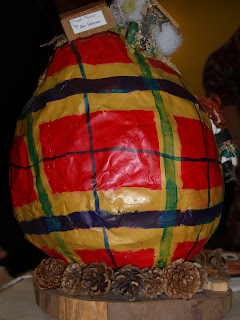 Easter
egg(C and G) Ann’s version of a ‘Scotch Egg’ – inside a haggis nursery and
whiskey distillery with the waste product scotch mist leaving via the chimney.
Easter
egg(C and G) Ann’s version of a ‘Scotch Egg’ – inside a haggis nursery and
whiskey distillery with the waste product scotch mist leaving via the chimney.16th February 2017
Embroidery and Screen Printing in collaboration with others
by Chloe Hamill
Chloe undertook an Art foundation course at Falmouth this
included screen printing, embroidery, machine stitching and 3D forms. One of
the 3D projects was cups and vessels, which inspired her to consider issues in
society and use her work to bring these to the attention of the audience. The
vessels linked to the women who collect water for their families often walking
great distances and carrying the weight on their heads as they return, whilst
the cups naturally led her thoughts to tea and then to the Fair Trade movement
and Chloe used these elements to decorate here work.

 Next she embarked on a BA Embroidery degree at Manchester
and whilst here she had many opportunities to develop her work. Examples of
this are work for the clothing company ‘Oasis’ where Chloe laser cut wood and
used appliqué to attach this, use of a multi head machine to create an
embroidery based on Moroccan tiles which
was then used on clothing. A competition in which she entered a ‘peacocks head’
design led to her work being used by ‘Purvah’ who used the design to feature on
a cushion but changed the colours. A learning experience for Chloe to find
companies could change colours etc without consultation once the design
belonged to them.
Next she embarked on a BA Embroidery degree at Manchester
and whilst here she had many opportunities to develop her work. Examples of
this are work for the clothing company ‘Oasis’ where Chloe laser cut wood and
used appliqué to attach this, use of a multi head machine to create an
embroidery based on Moroccan tiles which
was then used on clothing. A competition in which she entered a ‘peacocks head’
design led to her work being used by ‘Purvah’ who used the design to feature on
a cushion but changed the colours. A learning experience for Chloe to find
companies could change colours etc without consultation once the design
belonged to them.She has undertaken various placements including India where the Jacobs Well Charity teaches women embroidery, tailoring etc. Whilst there Chloe visited factories and experienced the conditions as well as child labour being used to make goods – which were sold in the developed world, by companies some of whom say they do not use child labour.
She enjoyed working with the people and this together with
her experiences made her want to tell the story as well as using, when
possible, fair trade fabric. To do this Chloe screen printed images of the
world onto fair trade fabric and then hand stitched the story into the image of
the world, leaving the needle and thread in position and the work unfinished to
give us the chance to change the life of the children.
 Other images Chloe uses are ‘birds’ and these can be seen screen printed onto
fabric and stitched into to tell stories of women. She selected this to
represent women as men often refer to women as birds. Also birds
Other images Chloe uses are ‘birds’ and these can be seen screen printed onto
fabric and stitched into to tell stories of women. She selected this to
represent women as men often refer to women as birds. Also birds  like pheasants
have personality e.g. they run across the road in front of you rather than
retreating back into the hedgerow and this interests her, also the fact that
birds migrate from one country to another helped Chloe to express her thoughts
in relation to women through the creation of maps with images on them.
like pheasants
have personality e.g. they run across the road in front of you rather than
retreating back into the hedgerow and this interests her, also the fact that
birds migrate from one country to another helped Chloe to express her thoughts
in relation to women through the creation of maps with images on them.
 Rainbow Haven is a drop in centre where women learn skills
and although they all speak different languages Chloe took in fabrics, threads
and needles for the women to use which helped to communicate ideas, helping
with the conversations between them. They made cushions and many returned
weekly so Chloe saw an opportunity to get them involved in a project where they
used their embroidery skills to stitch their name onto the country they came
from or to stitch the name of the country, although many found it difficult to
identify their country of origin.
Rainbow Haven is a drop in centre where women learn skills
and although they all speak different languages Chloe took in fabrics, threads
and needles for the women to use which helped to communicate ideas, helping
with the conversations between them. They made cushions and many returned
weekly so Chloe saw an opportunity to get them involved in a project where they
used their embroidery skills to stitch their name onto the country they came
from or to stitch the name of the country, although many found it difficult to
identify their country of origin. 
From this and the fact that when the women moved they
carried their belongings in a bag came
the idea to create a series of rucksacks screen printed with birds based on the
countries that the women came from. The instructions for making are printed on
the inside, and as part of the decoration on the bag there are pieces which can
be cut out and made up into a bird whilst making the bags provides a source of
income for the women.
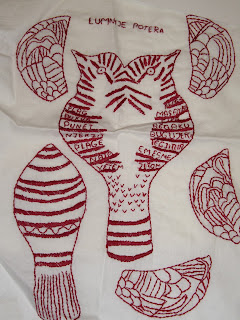


 Workshops continue to inspire Chloe and a Craft and Design
Day in the old fish market in Manchester led to screen printed fish which
people were asked to embroider and make up, these when sold provided funds for
the RNLI.
Workshops continue to inspire Chloe and a Craft and Design
Day in the old fish market in Manchester led to screen printed fish which
people were asked to embroider and make up, these when sold provided funds for
the RNLI.
Studying for her MA in Manchester Chloe lodged with a lady named Dorothy who was one of the first women to go to Oxford and whilst there she went to Germany on an exchange with Jewish girls, who stayed in the UK instead of returning to Germany. Tactile Too asked Chloe to create a piece of work (sketch book and final piece) and she used Dorothy’s story as her inspiration.
 He MA encouraged her to move away from textiles and saw the
making of an installation from 2000 butterfly wings which correlated with the
number of women being trafficked for sex.
He MA encouraged her to move away from textiles and saw the
making of an installation from 2000 butterfly wings which correlated with the
number of women being trafficked for sex.The Manchester Aid to Kosovo was set up after the war and 5 children who survived following the killing of the rest of their family came to Manchester. Chloe helps with the summer school and started children’s embroidery; this led to work with 20 widows of the war who she taught to embroider, initially making place mats and then creating 50 limited edition CD covers which were sold to raise money for the charity and now the women send their work to the UK to be sold.

There is an installation in the Imperial War Museum North in the exhibition of ‘Stories of War’ featuring 300 birds, the birds are embroidered in the same colour but each features the words of its creator.
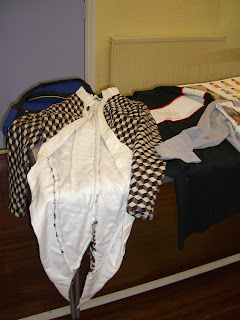 Chloe has lectured at Salford University and is now at
Bedales School teaching pattern cutting and embroidery. She is now using the
pattern cutting and making of garments to tell stories (examples of work from
GCSE and A level students including the brown and cream jacket where the
student made her own fabric by ribbon weaving and made it into the jacket) –
life is all about learning new skills and experiencing new opportunities.
Chloe has lectured at Salford University and is now at
Bedales School teaching pattern cutting and embroidery. She is now using the
pattern cutting and making of garments to tell stories (examples of work from
GCSE and A level students including the brown and cream jacket where the
student made her own fabric by ribbon weaving and made it into the jacket) –
life is all about learning new skills and experiencing new opportunities.
19th January 2017
Members Meeting
 The meeting saw the tables set round the hall
providing the opportunity for members to catch up and socialise whilst helping to prepare items for the
120 ‘Goody Bags’ to be given out at the Regional Day which we are hosting.
The meeting saw the tables set round the hall
providing the opportunity for members to catch up and socialise whilst helping to prepare items for the
120 ‘Goody Bags’ to be given out at the Regional Day which we are hosting.
The theme for this is ‘Pathways’ - we have collected O S maps featuring the West Midlands region and stuck these onto card, which was then cut up.
Tasks to complete
Stitching pathways onto the labels for the goody bags
Ironing and cutting up donated fabric into squares
Sorting donated beads for sale or goody bags
The raffle was drawn and ‘winners’ selected their prizes.

8th December 2016
Christmas Lunch and Surprise Speaker
Members gathered at Brookfield Golf Club for coffee at 10.30
bringing with them Christmas greetings, cards and gifts for friends and of
course the broaches made for the ‘Christmas Swap’.


The tables set for lunch, looked very festive and luxurious
with gold cloths and serviettes, green and gold table centres containing the cyclamen
(a gift for one of those on each table at the end of the meal), Christmas crackers,
table name cards featuring Women celebrated for their work in Embroidery e.g.
May Morris and the red gift pockets for each member.
There were over 30 broaches all created using a variety of
techniques and all very different, they made a wonderful display and the
recipients were delighted with the broach gained in the exchange, many being
pinned on immediately.

After the refreshments and chat it was time for Trisha to
welcome us, reminding us at the January members meeting we would need basic
sewing kit and glasses if required.
 Then the introduction of our surprise
speaker Meredith Towne who gave a very lively, enjoyable and informative
presentation entitled ‘Glitz and Glamour’.
This highlighted ladies evening wear in the early 20th
Century and featured the social history of the period that produced the changes
in style, decoration and hem lines. Meredith brought a wonderful selection of
original clothes, many of which featured embroidered and beaded decoration,
with which to illustrate her talk.
Then the introduction of our surprise
speaker Meredith Towne who gave a very lively, enjoyable and informative
presentation entitled ‘Glitz and Glamour’.
This highlighted ladies evening wear in the early 20th
Century and featured the social history of the period that produced the changes
in style, decoration and hem lines. Meredith brought a wonderful selection of
original clothes, many of which featured embroidered and beaded decoration,
with which to illustrate her talk.



The tables set for lunch, looked very festive and luxurious with gold cloths and serviettes, green and gold table centres containing the cyclamen (a gift for one of those on each table at the end of the meal), Christmas crackers, table name cards featuring Women celebrated for their work in Embroidery e.g. May Morris and the red gift pockets for each member.

After the refreshments and chat it was time for Trisha to welcome us, reminding us at the January members meeting we would need basic sewing kit and glasses if required.
 Then the introduction of our surprise
speaker Meredith Towne who gave a very lively, enjoyable and informative
presentation entitled ‘Glitz and Glamour’.
This highlighted ladies evening wear in the early 20th
Century and featured the social history of the period that produced the changes
in style, decoration and hem lines. Meredith brought a wonderful selection of
original clothes, many of which featured embroidered and beaded decoration,
with which to illustrate her talk.
Then the introduction of our surprise
speaker Meredith Towne who gave a very lively, enjoyable and informative
presentation entitled ‘Glitz and Glamour’.
This highlighted ladies evening wear in the early 20th
Century and featured the social history of the period that produced the changes
in style, decoration and hem lines. Meredith brought a wonderful selection of
original clothes, many of which featured embroidered and beaded decoration,
with which to illustrate her talk.

17th November 2016
Paper, Stitch, Passion and Purpose by Bridget Bowie
Bridget has a degree in textiles and embroidered textiles,
from this she started teaching Art to 11 to 18 yr olds and then 10 years ago
changed direction again to become a self employed Artist. This freedom came as
a bit of a shock after the routine of school, so she set out to develop her own
routine and with this the thoughts about what she was going to create , how to
develop her work and become more widely known.
When Bridget was teaching she used paper and card, working
with smaller pieces, off cuts etc so she decided on this as her starting point
for work at home. This involved the manipulation of different types of paper,
staining using various mediums and stitching the results together. There were
many influences on her work including cultures for example Indian. Bridget
developed a range of paper samples which she used for cards as well as using
the paper to produce images.
Initially she ran workshops focusing on the use of paper and
then needed to challenge herself, which came about through Crewe and Nantwich
together with Cheshire Council and the ‘Econet Project’. This looked at the
environment and involved exploring various outcomes other than pictures e.g.
labels/tag and a flat pack bird box.
Bridget met others on this project which
developed her ideas and resulted in a group of 4 signing up for an MA at
MMU. This produced a change of direction,
via an installation project at Victoria Baths in Manchester, which led to her
work telling a story. She collected stories/ memories from people who had used
the baths, involving bathing hats and swim suits, towels etc. How to use this information to produce the
installation, which by its nature takes time to create and set up, is not
present for long and is then disassembled. Bridget decided to collect towels,
roll them up (as one did with swim wear inside) and attach name tapes to them
which had different stories printed onto them.
The MA was Art as an Environment (selected to be different
from her original textiles) about our human environment and how we (Bridget)
fit into this. The first task for her MA was to ‘Make Something’ the item Bridget selected was a dress for a
doll – strange you might think but she visited her Mother on a day a week basis
through the course and her mother would present her with different items. The
doll was wearing a dress that Bridget had made for it when she was about 7
years old and she decided to recreate the dress, this brought about the
realisation that for her the process was a major part of the work rather than
the outcome. Before starting she had to think in terms of how it affected her,
what she knew and how we retain memories.
Bridget’s interest in memory, how it functions and affects
creativity resulted in a project working with a group whose members had
suffered a stroke, the group used images or items that were a part of their
memories to produce pieces of work. These are displayed in the Eagle Bridge
Health Centre.
Life drawing featured as part of the course and from this
Bridget developed the process of cutting away the figure resulting in space
around the figure (this linked with the death of a friend). She also works with
tracing paper making positive and negative images, stitching paper together and
seeing the parts removed as being fragile whilst pieces that remain are more
solid.
Bridget’s Work since her MA has focused on what has been
removed e.g. removing sections from paper and machine stitching over the void. This process causes different things to happen
in terms of the paper changing shape, Bridget has little control over what
occurs and although she did not start with a particular outcome in mind during
her working it evolved into a 3D hanging.
Throughout her work Bridget uses photos of her work as part
of the process to further develop work/generation and exploration of ideas, it
helps her to look at her ideas differently for example when viewed from the
side it is contained whilst when viewed from above it looks open differing
perspectives.
Exhibitions have been ‘Off the Wall’ at little Moreton Hall
based on ruffs from Tudor dress and ‘Unravel’ the theme being to show the story
behind something eg her work featuring sketch books, process, samples,
exploration of ideas
20th October 2016
Goldwork by Golden Hinde
15th September 2016
AGM
At the AGM there were displays of the Travelling Books from 2016 , the items entered into the 'Chairmans' Challenge' competition for members to vote on and select a winner, members work created at the various workshops during the year as well as a raffle for a range of prizes.




 The work entered for the challenge was excellent and varied in terms of techniques which provided members with very difficult decisions as to which piece to select as their favourite.
The work entered for the challenge was excellent and varied in terms of techniques which provided members with very difficult decisions as to which piece to select as their favourite.


Also
on display were the travelling books and work that members had
undertaken at the various workshops, both in house and delivered by
external speakers, throughout the last year.
There were two presentations
The first was 25 year Embroiderers' Guild membership certificates awarded to Marjorie Derbyshire and Sheila Webster.

 The second was to Linda Hall the winner of the Chairmans Challenge members vote pictured with her winning entry
The second was to Linda Hall the winner of the Chairmans Challenge members vote pictured with her winning entry 21st July 2016
Members meeting ‘Afternoon Tea at Lunchtime’
 The meeting was lively with plenty to do including a sales
table, with lots of contributions which proved very popular,
The meeting was lively with plenty to do including a sales
table, with lots of contributions which proved very popular,a raffle with many interesting prizes and Maggi Phillips sales table raising money for the overseas charity she supports.

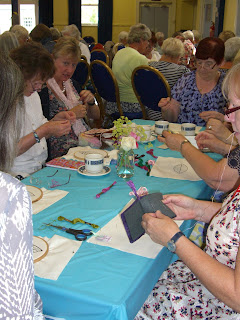 Members sat at tables (max of 8 people) so plenty of
opportunity to socialise whilst having tea/coffee, then after the notices came
the challenge. everyone was given a piece of fabric with a
leaf printed onto it, a range of embroidery threads, needles and scissors had
been provided, the owner of each was given 5 minutes to stitch part of the leaf
in a stitch of their choice, then time was called and the work passed to the
next person at the table to repeat the process, this was repeated until the
leaf returned to its owner all that remained was to complete the leaf!
Members sat at tables (max of 8 people) so plenty of
opportunity to socialise whilst having tea/coffee, then after the notices came
the challenge. everyone was given a piece of fabric with a
leaf printed onto it, a range of embroidery threads, needles and scissors had
been provided, the owner of each was given 5 minutes to stitch part of the leaf
in a stitch of their choice, then time was called and the work passed to the
next person at the table to repeat the process, this was repeated until the
leaf returned to its owner all that remained was to complete the leaf!
 Then it was time for the committee to bring out the, flowers, cutlery, platters
of sandwiches, cake stands laden with a selection of scones, fruit tarts, cup
cakes, chocolate slices, the bowls of strawberries, jam and cream and of course
cups of tea.
Then it was time for the committee to bring out the, flowers, cutlery, platters
of sandwiches, cake stands laden with a selection of scones, fruit tarts, cup
cakes, chocolate slices, the bowls of strawberries, jam and cream and of course
cups of tea.
The raffle was drawn ( 8 winners),
prizes selected, thanks given for the Afternoon tea and with many wishes for a
good summer and ‘see you in September’ the meeting ended - another successful year.
16th June 2016
Landlines, drawn lines, stitched lines by Amanda Hislop
Amanda was interested in art and textiles, she went to
art college for her foundation course and applied to Goldsmiths although she
actually studied for a degree in woven textiles and painting at Farnham.
Following this she trained to teach and ended up teaching in Wantage,
Oxfordshire at a girl’s boarding school where Amanda introduced textiles,
embroidery and machine embroidery into her art classes. Eventually the school
merged and Amanda took redundancy, moving on to a Masters Class where she met
up with Julia Caprara and then became a member of ‘Prism’ Textile inspired Art.
At home Amanda works in a studio(3x3.5 m), which houses a
Bernina 807(which she used at school), a
Viking Husquvana 425, and a recently acquired Bernina 830 which is a bigger
machine with a knee lift to raise the presser foot (which she is getting used
to). Her studio looks out over fields and she uses this landscape of hills,
trees, sown and ploughed fields and vegetation for inspiration. Living close to
the ‘Ridgeway’ and walking her dogs along this path also provides plenty of
ideas and opportunities to take photos which can be used later.
 Amanda works on muslin using acrylic paints and will
combine elements from different landscapes or remove posts or features which
she does not require. She also learns from each piece of work especially those
where she has used a particular paper or fabric that has been very difficult to
stitch into or created other problems. Another source of ideas is a sketch book
which belonged to her grandfather (who died when she was about 8 years old), it
includes sketches of cow parsley, wire fences etc.
Amanda works on muslin using acrylic paints and will
combine elements from different landscapes or remove posts or features which
she does not require. She also learns from each piece of work especially those
where she has used a particular paper or fabric that has been very difficult to
stitch into or created other problems. Another source of ideas is a sketch book
which belonged to her grandfather (who died when she was about 8 years old), it
includes sketches of cow parsley, wire fences etc. Amanda’s work features ink and bleach – a type of
resist/discharge technique, mark making is used to create grasses, Mark making
is a visual language, this and drawn lines are an important part of her work.
Amanda produces studies using drawn lines, which become stitched lines; she
will then paint the surface, create the structure with hand stitches (usually
long and short stitches, seeding, ‘Y’ and French knots) and then machine stitch(
this will be straight or zig zag or a combination of both).
Amanda’s work features ink and bleach – a type of
resist/discharge technique, mark making is used to create grasses, Mark making
is a visual language, this and drawn lines are an important part of her work.
Amanda produces studies using drawn lines, which become stitched lines; she
will then paint the surface, create the structure with hand stitches (usually
long and short stitches, seeding, ‘Y’ and French knots) and then machine stitch(
this will be straight or zig zag or a combination of both).  She also uses a range of fabrics including cotton rag
paper(150gms – crumpled up or uncrumpled),Abaca tissue, conservation tissue, teabag paper( these 2
have wet strength meaning they can be used when dyeing) and often works on calico with paper laid over
it so she can paint it using an acrylic wash and then embroider into it. Amanda
tends to use a limited colour palette which are natural and comprise liquid
acrylics or system 3 acrylics.
She also uses a range of fabrics including cotton rag
paper(150gms – crumpled up or uncrumpled),Abaca tissue, conservation tissue, teabag paper( these 2
have wet strength meaning they can be used when dyeing) and often works on calico with paper laid over
it so she can paint it using an acrylic wash and then embroider into it. Amanda
tends to use a limited colour palette which are natural and comprise liquid
acrylics or system 3 acrylics.
Amanda also
stitches onto dissolvable fabric, firstly laying threads onto it (forming
grasses) and then stitching into them and then applying them to her painted
canvasses using hand stitch, more recently she has been using ‘Aqua bond’ for
this.
 Experimentation also develops her
work for example a layered piece which Amanda cut into sections and put ‘Thermo
gauze’ in between stitching grasses into this and then melting the gauze to
leave the stitches which represented the grasses blowing in the wind thus
providing movement in the piece.
Experimentation also develops her
work for example a layered piece which Amanda cut into sections and put ‘Thermo
gauze’ in between stitching grasses into this and then melting the gauze to
leave the stitches which represented the grasses blowing in the wind thus
providing movement in the piece.
 Experimentation also develops her
work for example a layered piece which Amanda cut into sections and put ‘Thermo
gauze’ in between stitching grasses into this and then melting the gauze to
leave the stitches which represented the grasses blowing in the wind thus
providing movement in the piece.
Experimentation also develops her
work for example a layered piece which Amanda cut into sections and put ‘Thermo
gauze’ in between stitching grasses into this and then melting the gauze to
leave the stitches which represented the grasses blowing in the wind thus
providing movement in the piece.
Throughout Amanda looks for layers and lines in the
landscapes, and always takes a sketch book with her especially on holiday when
she fills it with ideas using ink/ water and bleach. Work entitled ‘Big Skies
and Rain’ came from a holiday in Wales when it rained a lot.




 Mixed media is also used and enables her to push the
boundaries with her work for example stitching onto paper and glues this onto
pictures.
Mixed media is also used and enables her to push the
boundaries with her work for example stitching onto paper and glues this onto
pictures.
Another focus is trees particularly the light through the
trees, against the darkness of the trees themselves e.g. larch, being a weaver
– working with horizontal and vertical threads in work and designs- these
remind Amanda of herringbone weave.




 Each year Prism has a different theme for work which
provokes different ideas and pieces including’ I must go down to the sea again,
a piece which uses cellulose paste to bond CNC – this thickens the fabric so it
is firm enough to stitch but which softens once stitched and the seascape was
added using layers of paper, fabric and thread.
Each year Prism has a different theme for work which
provokes different ideas and pieces including’ I must go down to the sea again,
a piece which uses cellulose paste to bond CNC – this thickens the fabric so it
is firm enough to stitch but which softens once stitched and the seascape was
added using layers of paper, fabric and thread. 
The 2011 theme was ‘Up Close in Detail’ for which Amanda created work based on the Dorset cliffs and the fossils on the shore.


The 2012 theme was ‘Hidden Places, Hidden Spaces’ this work came from an isolated beach, where things hidden by the sea are revealed as the tide ebbs for example seaweed, fishing line shells, rocks etc. Amanda does not like the rock in the middle of the picture so will cut the piece up and rework it.
 The 2013 theme was ‘From Sketch to Stitch’ this is a
liminal process you go through in order to get to the end product/point –
Amanda has a big sketch book which records the process behind the idea which
originates from a holiday in Cornwall.
The 2013 theme was ‘From Sketch to Stitch’ this is a
liminal process you go through in order to get to the end product/point –
Amanda has a big sketch book which records the process behind the idea which
originates from a holiday in Cornwall.
The 2014 theme was ‘Coded: Decoded’ this was a landscape
produced as a free standing piece(an experiment) and is now in book format
comprising fragments of the landscape.
 The 2015 theme was ‘Lines of Communication’ - this was a
new venue for the exhibition – Hoxton Arches (under a railway) and work had to
be hung, but with limitations due to transport it had to be a smaller piece.
Amanda created a piece based on weaving in which the land unfolds as the pleats
are opened revealing the work underneath. Her sketch book provides a record of
the process including experiments, trial pieces and samples.
The 2015 theme was ‘Lines of Communication’ - this was a
new venue for the exhibition – Hoxton Arches (under a railway) and work had to
be hung, but with limitations due to transport it had to be a smaller piece.
Amanda created a piece based on weaving in which the land unfolds as the pleats
are opened revealing the work underneath. Her sketch book provides a record of
the process including experiments, trial pieces and samples.
The 2016 theme was ‘Fracture’ and for this a piece of
flint picked up on her travels was used, inspiring with its colours and shape.
In her sketchbook Amanda has applied colour to the pages rather than working
onto white whilst the piece created is sealed with acrylic wax to give a shiny
leather like surface.
19th May 2016
Suzette lived in Wales on a farm near to the mountains and
the sea, the family had a sailing boat and went to Anglesey, her grandmother
painted and all this has served to inspire her and can be seen in her work.
 She did fashion and textile design at university but this
was really the wrong course for Suzette as she had always loved embroidery. In
2002/3 she bought a new sewing machine and this enabled her to create/produce
work more quickly than previously when she had worked by hand.
She did fashion and textile design at university but this
was really the wrong course for Suzette as she had always loved embroidery. In
2002/3 she bought a new sewing machine and this enabled her to create/produce
work more quickly than previously when she had worked by hand. Suzette’s first pieces of work, about 1998 (following the
death of her parents) were reflective looking back to the farm, land and sea.
These were also the pieces where she was learning about the machine and
experimenting with different fabrics like handmade felt.
Suzette’s first pieces of work, about 1998 (following the
death of her parents) were reflective looking back to the farm, land and sea.
These were also the pieces where she was learning about the machine and
experimenting with different fabrics like handmade felt.
The tree of life was
one of these pieces and featured birds, figures etc which still feature in her
work.
 With experience Suzette applied stabiliser onto calico and
used a frame which meant that she had much more control when working. The
pieces of work were based on family days out e.g. on the beach, Suzette draws
out ideas in pencil and uses variegated thread - this ensures the out lines are
not to solid.
With experience Suzette applied stabiliser onto calico and
used a frame which meant that she had much more control when working. The
pieces of work were based on family days out e.g. on the beach, Suzette draws
out ideas in pencil and uses variegated thread - this ensures the out lines are
not to solid. 
 She also uses characters like dogs, foxes, birds as well as
leaves and trees in her work which she has developed and translated into 3 D forms
so they come out from the picture with many like the birds being presented on
blocks of wood etc.
She also uses characters like dogs, foxes, birds as well as
leaves and trees in her work which she has developed and translated into 3 D forms
so they come out from the picture with many like the birds being presented on
blocks of wood etc.  Suzette makes use of various items e.g. wood, metal and
also recycles fabric pieces including experimental samples from her ‘sketch’
books to feature in her work. (for example the 'woodpecker')
Suzette makes use of various items e.g. wood, metal and
also recycles fabric pieces including experimental samples from her ‘sketch’
books to feature in her work. (for example the 'woodpecker') The boats and figures have been created using water soluble
fabrics and also with layers of fabrics and synthetic felt which are then
stitched into, following this a soldering iron is used to melt the work
creating holes, Suzette then makes these into models like the boat and flag.
The boats and figures have been created using water soluble
fabrics and also with layers of fabrics and synthetic felt which are then
stitched into, following this a soldering iron is used to melt the work
creating holes, Suzette then makes these into models like the boat and flag. Suzette has also written books but it is with words rather
than pictures that these are compiled, she usually has a book on the go which
also inspires her to work.
Suzette has also written books but it is with words rather
than pictures that these are compiled, she usually has a book on the go which
also inspires her to work.  The quilt took 8 months to complete and Suzette used a
vintage dress as the basis for this, using the lining, top fabric, straps etc,
the patches on the quilt are pieces of recycled embroidery, and letters also
feature. The idea for the quilt had been with Suzette for a while and she had
sketches but it was really a ‘developing piece’ as she had no ideas as to exactly
how it would look when finished.
The quilt took 8 months to complete and Suzette used a
vintage dress as the basis for this, using the lining, top fabric, straps etc,
the patches on the quilt are pieces of recycled embroidery, and letters also
feature. The idea for the quilt had been with Suzette for a while and she had
sketches but it was really a ‘developing piece’ as she had no ideas as to exactly
how it would look when finished.  Ideas came from a map, walking along a canal
towpath, nature and figures/people met, part of the work is quilted using a
grid but also features hand stitch. There is a forest of trees which makes use
of recycled embroidery, but in order to change the colour or tone it down
Suzette will cover sections with lace or organza and then cut out areas to
reveal the brighter colour.
Ideas came from a map, walking along a canal
towpath, nature and figures/people met, part of the work is quilted using a
grid but also features hand stitch. There is a forest of trees which makes use
of recycled embroidery, but in order to change the colour or tone it down
Suzette will cover sections with lace or organza and then cut out areas to
reveal the brighter colour.
A large white rabbit, called buster, which was put in a
telephone box to keep him safe until collected, had a limerick written about
his situation and Suzette turned this into a picture with the writing done free
hand on the machine.
 A similar picture was created about two collared doves
again with a written passage.
A similar picture was created about two collared doves
again with a written passage.
 A similar picture was created about two collared doves
again with a written passage.
A similar picture was created about two collared doves
again with a written passage. The tea cups and saucers pieces were inspired by Suzettes’
grandmother and her friends meeting for tea when ‘Aunt Jean’ would read the tea
leaves.
The tea cups and saucers pieces were inspired by Suzettes’
grandmother and her friends meeting for tea when ‘Aunt Jean’ would read the tea
leaves. 

A Madeira Threads competition in 2004 entitled ‘Glimpses of India’ led Suzette to make 3D teacups and saucers – these are made as 2D and then put into a cup to mould them- and include tea leaves and ‘Masala Chai’.
 Suzette has also run various workshops including ones
featuring boxes, using pelmet Vilene with layers of fabric stitched on top, she
has also experimented with machines and techniques and a casket which she
produced led to a commission from the University church of Oxford to produce a
large (35cm x 110cm) fully stitched picture.
Suzette has also run various workshops including ones
featuring boxes, using pelmet Vilene with layers of fabric stitched on top, she
has also experimented with machines and techniques and a casket which she
produced led to a commission from the University church of Oxford to produce a
large (35cm x 110cm) fully stitched picture.
 ‘Rose Queen sash’ - for this she used an existing sash (which
belonged to her mother) which she cut up and reassembled back into a sash
shape. The recycling of clothes and fabrics to create compositions together
with experimenting with different threads including thicker ones in the bobbin
to give a tapestry feel (she then sews on the reverse of the work) are all features
of Suzettes work.
‘Rose Queen sash’ - for this she used an existing sash (which
belonged to her mother) which she cut up and reassembled back into a sash
shape. The recycling of clothes and fabrics to create compositions together
with experimenting with different threads including thicker ones in the bobbin
to give a tapestry feel (she then sews on the reverse of the work) are all features
of Suzettes work.21st April 2016
 Creative Surfaces by Lynda Monk (a mixed-media textile
artist, who uses materials such as Kunin Felt, Tyvek and Lutradur to create
textured and unusual surfaces.)
Creative Surfaces by Lynda Monk (a mixed-media textile
artist, who uses materials such as Kunin Felt, Tyvek and Lutradur to create
textured and unusual surfaces.) Lynda started her career in textiles wanting a knitting
machine and once acquired she made jumpers, from this she looked for evening
classes to extend what she was doing and found C and G in machine knitting.
Lynda started her career in textiles wanting a knitting
machine and once acquired she made jumpers, from this she looked for evening
classes to extend what she was doing and found C and G in machine knitting.  Her
tutor introduced her to creative embroidery which led to Lynda stopping
knitting after her part 1 . Instead of going on to part 2 she went to shows and
bought books and kits to work on, then Lynda moved house and started using
distance learning completing work through a blog, this then took over becoming
a main way of communicating and leading to books, workshops e.g. ‘Pinked,
Puffed and Pulled’ - Elizabethan costume the waistcoat is poly velvet which has
been foiled, covered in organza and then put through the embellisher
Her
tutor introduced her to creative embroidery which led to Lynda stopping
knitting after her part 1 . Instead of going on to part 2 she went to shows and
bought books and kits to work on, then Lynda moved house and started using
distance learning completing work through a blog, this then took over becoming
a main way of communicating and leading to books, workshops e.g. ‘Pinked,
Puffed and Pulled’ - Elizabethan costume the waistcoat is poly velvet which has
been foiled, covered in organza and then put through the embellisher Slinky secrets – Lynda prints onto tissue paper( old
paper patterns) using the laser printer.eg fly motif, this is then glued onto
the backing fabric, stitched through and coloured in.
Slinky secrets – Lynda prints onto tissue paper( old
paper patterns) using the laser printer.eg fly motif, this is then glued onto
the backing fabric, stitched through and coloured in. Encrusted blades structures are made from acrylic felt (created
from recycled plastic bottles), this can then be melted. This is then backed
onto pelmet Vilene with a layer of Lutradur in between to stop the fabric
buckling, machine stitch is applied as either a wavy line grid or circles, with
the final stage using acrylic paints to colour.
Encrusted blades structures are made from acrylic felt (created
from recycled plastic bottles), this can then be melted. This is then backed
onto pelmet Vilene with a layer of Lutradur in between to stop the fabric
buckling, machine stitch is applied as either a wavy line grid or circles, with
the final stage using acrylic paints to colour.  Lynda’s first book 'Stitching
the Textured Surface', was written with Carol McFee and explores the use of
gesso and molding paste to create amazing textured surfaces which she then ‘zaps’
( applies heat to in order to obtain further effects/detail).
Lynda’s first book 'Stitching
the Textured Surface', was written with Carol McFee and explores the use of
gesso and molding paste to create amazing textured surfaces which she then ‘zaps’
( applies heat to in order to obtain further effects/detail).

Her second book 'Fabulous Surfaces' uses tissue papers combined with foils and acrylic mediums producing metallic effect surfaces and more. Lynda has used this technique to create wearable art constructed using Evolon as the background to obtain the metallic effect. This is also seen in the vessels and gift bags.
The third book in 2012 was
 the quickest to write, 'Exploring Creative Surfaces' looks at creating more
unique surfaces using scrim, polyester fabrics, foils and mixed media products.
the quickest to write, 'Exploring Creative Surfaces' looks at creating more
unique surfaces using scrim, polyester fabrics, foils and mixed media products.
Folded pocket books(Granny’s
boasting books for photos) consist of Lutradur covered in gift wrap tissue paper
(on each side) which is bonded on using bondaweb and then coloured with e.g.
walnut ink which then has salt sprinkled on, this is allowed to dry.
 The white flowers/leaves make
use of Lutradur and Xpandaprint (puff paint) and a heat gun as when heat is
applied the Xpandaprint puffs up whilst the Lutradur melts creating the lacy
effect, wire is then used to stiffen the veins of the leaves/petals.
The white flowers/leaves make
use of Lutradur and Xpandaprint (puff paint) and a heat gun as when heat is
applied the Xpandaprint puffs up whilst the Lutradur melts creating the lacy
effect, wire is then used to stiffen the veins of the leaves/petals. Three pictures- First one is
inspired by the ‘Bone Church’ in Kutna Hora Prague where garlands
of human skulls, a bone chandelier and chalices decorate this small Gothic
chapel.
Three pictures- First one is
inspired by the ‘Bone Church’ in Kutna Hora Prague where garlands
of human skulls, a bone chandelier and chalices decorate this small Gothic
chapel. The second is ‘Postman’s Park’ in
London -this scenic park acquired its name due to its popularity as a lunchtime
garden with workers from the nearby old General Post Office. It is home to the
famous Watts memorial, built in 1900 by Victorian painter and philanthropist GF
Watts (1817-1904).
The second is ‘Postman’s Park’ in
London -this scenic park acquired its name due to its popularity as a lunchtime
garden with workers from the nearby old General Post Office. It is home to the
famous Watts memorial, built in 1900 by Victorian painter and philanthropist GF
Watts (1817-1904).
Watts was a radical socialist with strong sympathies towards the dreadful
living conditions of the urban poor, and in 1887, wrote to the Times proposing
that a park commemorating 'heroic men and women' who had given their lives
attempting to save others would be a worthy way to mark Queen Victoria's Golden
Jubilee year. This eventually took the form of the Watts gallery in Postman's
Park.
Along the walls of the gallery, Watts placed glazed Doulton tablets
commemorating acts of bravery, each one detailing the nature of the heroic act.
The tragic tales documented on the tiles are touching, often involving children
and usually concerning fire, drowning or train accidents.
 Third is ‘the Cross Bones Graveyard’ Southwark
an unconsecrated graveyard for prostitutes or’ Winchester Geese’ by the 18th
century it had become a paupers’ burial ground which closed in 1853.
Third is ‘the Cross Bones Graveyard’ Southwark
an unconsecrated graveyard for prostitutes or’ Winchester Geese’ by the 18th
century it had become a paupers’ burial ground which closed in 1853. Sketch books are created from samples/ experiments with the processes being described fully
Sketch books are created from samples/ experiments with the processes being described fully
17th March 2016
What Floats my Boat by Liz Brooke Ward

 Liz’s work covers all aspects involving fabric and
stitch, including quilts, she considers herself an enthusiast rather than a
specialist. She spends many hours in her ‘shed’ in the garden and takes her
inspiration from the natural world and landscapes including what she sees from
her work room.
Liz’s work covers all aspects involving fabric and
stitch, including quilts, she considers herself an enthusiast rather than a
specialist. She spends many hours in her ‘shed’ in the garden and takes her
inspiration from the natural world and landscapes including what she sees from
her work room.
Whilst working on her C and G Liz focused on lichens, an idea which came from the work of her scientist husband, who at that time was taking pictures of lichens through a microscope.
 She thought the images were so
textural that they were ideal for stitch, Liz created a simple design – a
circle, inscribed in a square which she cut into 4 and re arranged, then free
machined into to give texture.
She thought the images were so
textural that they were ideal for stitch, Liz created a simple design – a
circle, inscribed in a square which she cut into 4 and re arranged, then free
machined into to give texture.
The scale of the circles varies from 4” to 24”, the fabrics are hand dyed and she has printed onto the fabric( via the computer and printer), this has included the words of the poem ‘Walls’ by Robert Frost(lichen featuring on walls as yellow/orange/grey/green patches)

The long panel is based on the same theme but with stone shapes, which Liz quartered and re assembled, this was a second working of the idea as she was not happy with the original.
 Liz saves ‘waste pieces’ e.g. the outer pieces once
circles have been cut out etc and this has allowed her to create pieces
featuring the negative shapes which she stitches onto a base fabric and
enhances with stitch. She also uses the Fibonacci sequence which is a natural
shape.
Liz saves ‘waste pieces’ e.g. the outer pieces once
circles have been cut out etc and this has allowed her to create pieces
featuring the negative shapes which she stitches onto a base fabric and
enhances with stitch. She also uses the Fibonacci sequence which is a natural
shape. As well as large pieces Liz creates smaller versions which are entirely stitched with French knots.
 The leaf was the first time she used embroidery on
quilted work and employed the two stitches she knew – French/bullion knots and
blanket stitch.
The leaf was the first time she used embroidery on
quilted work and employed the two stitches she knew – French/bullion knots and
blanket stitch.Yellow / fawn piece focuses on lichens(fungus and algae) and employs mixed media including flour and water paste.
 As part of her C and G Liz created a quilt based on the
solar eclipse, featuring the band of darkness seeping across the sun, this uses
space dyed fabric and panel of moon shapes (the reverse is orange, red and
yellow).
As part of her C and G Liz created a quilt based on the
solar eclipse, featuring the band of darkness seeping across the sun, this uses
space dyed fabric and panel of moon shapes (the reverse is orange, red and
yellow).
 Cones made using dissolvable film, straight stitch and
then working over this with circles, Liz did not wash out all the film and so
they have some support and retain their shape.
Cones made using dissolvable film, straight stitch and
then working over this with circles, Liz did not wash out all the film and so
they have some support and retain their shape. Her entry for the Charles Henry Foyle competition was
entitled Maelstrom, swirling water, all the shapes were an oval, which was
distorted, and Liz changed the scale of the shapes from small to large and
created the feeling of movement by working on the diagonal. She used reverse
appliqué with shapes drawn on Vilene, dyed pieces for the front (marbled
fabric) and then created a string block which she then dabbed over the work to
give a pattern over the surface.
Her entry for the Charles Henry Foyle competition was
entitled Maelstrom, swirling water, all the shapes were an oval, which was
distorted, and Liz changed the scale of the shapes from small to large and
created the feeling of movement by working on the diagonal. She used reverse
appliqué with shapes drawn on Vilene, dyed pieces for the front (marbled
fabric) and then created a string block which she then dabbed over the work to
give a pattern over the surface.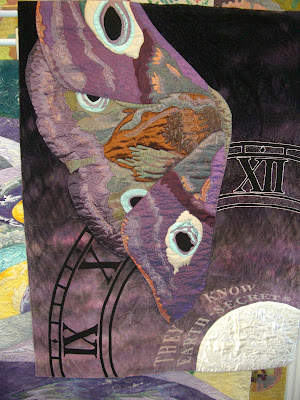 For the Festival of Quilts –Be Inspired the brief was
‘August’, Liz decided to use the poem ‘August Midnight’ by Thomas Hardy, in
which the light attracts insects – a moth, bee daddy long legs and flies. She
appliquéd words, tie dyed fabrics, recycled fabrics, layered silk, organza’s
and used velvet as a base.
For the Festival of Quilts –Be Inspired the brief was
‘August’, Liz decided to use the poem ‘August Midnight’ by Thomas Hardy, in
which the light attracts insects – a moth, bee daddy long legs and flies. She
appliquéd words, tie dyed fabrics, recycled fabrics, layered silk, organza’s
and used velvet as a base.  The first pictures that Liz created were landscapes
featuring the Slad valley for the centenary of Laurie Lee and one of the sun
rise across the valley which used hand dyed fabric and hand embroidery.
The first pictures that Liz created were landscapes
featuring the Slad valley for the centenary of Laurie Lee and one of the sun
rise across the valley which used hand dyed fabric and hand embroidery.18th February 2016
Hats, Flowers and Fascinators a fascinating journey by
Claire Muir
People often ask Claire about her sources of inspiration,
how she creates the items and why she does what she does and this led to her
presentation.




Claire spent her childhood abroad, living in various exotic countries, where creatures especially lizards, tropical flowers, colours, bird of paradise feathers, dancing/movement /fluidity all impacted on her and feature in her work.
Following school she embarked on a 1 year foundation course
in Bournemouth exploring many areas (not textiles) e.g. screen printing onto
fabric using images of lizards. Claire then applied to Middlesex
Poly, Chelsea school of Art etc but without success and eventually ended up in
Chichester following an Art and related Arts course with an emphasis on
performing arts.
Fortunately she was interviewed by Carol Naylor and the
college had a fibres department.
Her first year was spent ‘dabbling’ - dying, felt and paper making etc, in the
second year she was introduced to free
machine embroidery and this was when Claire was able to realise her ideas,
creating 3 D items.
Alice Kettle workshops then brought embroidery to her, a
way to enhance her work further. As Claire did not want to make pictures, her
options were garments (she did not know how to make these) or hats – although
she did not know how to make hats she decided this was a better choice.
Her first hat was made using paper pulp which she dyed (pinks
and purples), she covered an existing straw hat and spooned the pulp over it,
however once dried it had lost its jewel like colour and so Claire decided to
embellish it with machine embroidery. Using Avalon soluble fabric to machine
embroider on she created a lace flower.
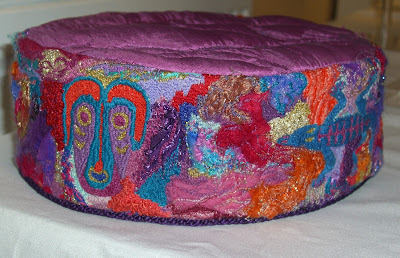 Her next hat had an Oceanic theme and featured lizards,
birds etc and was quilted on the top.
Her next hat had an Oceanic theme and featured lizards,
birds etc and was quilted on the top.  This was followed by a felt hat – Claire
manipulated the felt to give shape, embroidered using French knots and applied
decoration in the form of ‘pimples’ (made by free machining in circles on
Vilene using a thick bobbin thread, turning them through, stuffing them and
attaching to the hat) and lizards – one machine embroidered and the other made
in 3D and wired onto the hat.
This was followed by a felt hat – Claire
manipulated the felt to give shape, embroidered using French knots and applied
decoration in the form of ‘pimples’ (made by free machining in circles on
Vilene using a thick bobbin thread, turning them through, stuffing them and
attaching to the hat) and lizards – one machine embroidered and the other made
in 3D and wired onto the hat. In other experiments for her degree Claire machine embroidered onto soluble fabric to create a lace hat in 3 sections, brim, crown and tip, she then embellished with beading (applying them individually) and hand stitch amounting to 75hrs of work!
For her post graduate year Claire applied to Goldsmiths and
the Glasgow school of Art, which she decided to select. She was told that if
her focus was to be hats then she had to learn how to make them correctly.
 Following this Claire
embarked on her first hat (1 terms worth of work!!) was able to dye her own fabrics
(black bag method), select a source of inspiration, this time an oyster shell,
and create a ‘proper’ hat with a blocked crown, lined, labelled, pin tucked
with wire, stiffened with millinery stiffener, decorated with free machined
barnacles, smocked using a smocking machine. The threads used are Moderna
classic 40 – a viscose thread which have a good colour range available.
Following this Claire
embarked on her first hat (1 terms worth of work!!) was able to dye her own fabrics
(black bag method), select a source of inspiration, this time an oyster shell,
and create a ‘proper’ hat with a blocked crown, lined, labelled, pin tucked
with wire, stiffened with millinery stiffener, decorated with free machined
barnacles, smocked using a smocking machine. The threads used are Moderna
classic 40 – a viscose thread which have a good colour range available.
More hats followed
Throughout Claire was striving to make a machine embroidered lace hat but found it very difficult to stiffen them so they maintained shape as well as appearance. She participated in the New Designers Exhibition and was awarded a prize by The Worshipful Company of Drapers; with this Claire was able to buy hat blocks and machines enabling her to work at home.
Whilst experimenting she came up with the idea of a brim supported by spokes
and attached to the crown of the hat (Green), this led to her ‘Ascot’ hat (cream),
as well as a red hat which was heavily stitched and created for an exhibition.
Claire also created hats to match dresses – indeed with the first one someone suggested that she contacted the maker/designer of the dress and as a result she was given a voucher with which she acquired a second dress and the need to create a matching hat!

The beauty of the lace hats is they are light and easy to wear although very time consuming/labour intensive to make.
 This led to a
change in direction to the making of tiaras, headdresses, fascinators and
flowers, still using embroidery, feathers, flowers, wire together with the
application of beads, crystals etc.
This led to a
change in direction to the making of tiaras, headdresses, fascinators and
flowers, still using embroidery, feathers, flowers, wire together with the
application of beads, crystals etc.Other work that she has done was with a theatrical costumer where Claire was involved in designing and making hats/headdresses for the ice show in Blackpool- fortunately there was a big budget allowing for extravagant creations.
As well as making fascinators Claire also provides groups
with presentations and runs various workshops including free machine
embroidery, funky fascinators and fabulous flowers.
10th December 2015
Christmas meeting and lunch
 The venue for the Christmas meeting was Brookfield Golf
Club. On arrival at 10.30 members were welcomed with coffee, tea and biscuits
and the sight of the tables decorated with small ‘presents’ and cyclamen.
The venue for the Christmas meeting was Brookfield Golf
Club. On arrival at 10.30 members were welcomed with coffee, tea and biscuits
and the sight of the tables decorated with small ‘presents’ and cyclamen.
There
was the usual opportunity to chat, exchange cards, and look at the tables as
well as delivering the ‘key fob’ to Jean and Rita and receive a ticket for their
‘swap’ to be presented after lunch. The key fobs about 30 in total were colourful
and useful demonstrating creativity as well as showcasing a variety of
techniques.




Tricia – had an announcement about Alston Hall (the venue for our 2016 week end course) which was closing at the end of December 2015 due to funding cuts. We will try to find another venue or if this fails develop an alternative proposal.
 Following this our surprise speaker was introduced as ‘ Wynndebagge’
(Paul) a Medieval Musician and
Entertainer .
Following this our surprise speaker was introduced as ‘ Wynndebagge’
(Paul) a Medieval Musician and
Entertainer .
Paul has been a performer for 20 years and in addition to
giving talks and presentations works with the National Trust and English
Heritage. His name arose from his ability to play the bagpipes and also to
talk. Paul comes from a theatrical and musical background, with his aunt being
married to John Laurie.
As well as being dressed in period costume including
boots Paul brought with him a selection of hats, boots and of course musical
instruments.
The hats included - 14th / 15th
century style felt hat, a medieval ‘pill box’ type of hat and an Elizabethan
‘statute hat worn by the town band musicians or waites.

Paul informed us that in medieval time’s boots were
expensive as in order to make them 12 different measurements were required.
This meant that only the wealthy wore boots leaving the common folk wearing
wooden platens. The Civil war changed this as footwear was required for
soldiers etc and could not be handmade for individuals due to time and cost,
this led to mass produced foot wear of the one size fits all variety – with no
specific shoes for right or left feet!
Musical instruments – the common people were not allowed
brass so musical instruments were made from wood and bone.
Early instruments
 The Shawm – an Arabic
instrument (like the ones featured with Angels on Christmas cards), a
medieval/Elizabethan wooden trumpet with a reed, has a cone shaped hole down
its centre.
The Shawm – an Arabic
instrument (like the ones featured with Angels on Christmas cards), a
medieval/Elizabethan wooden trumpet with a reed, has a cone shaped hole down
its centre.  Crumhorn (Flemish term for bent horn) is a medieval wind
instrument with an enclosed double reed and an upward-curving end, it has a straight hole down its centre and
produces musical notes; these come in different sizes and so create different
notes.
Crumhorn (Flemish term for bent horn) is a medieval wind
instrument with an enclosed double reed and an upward-curving end, it has a straight hole down its centre and
produces musical notes; these come in different sizes and so create different
notes.
Bag pipe – a Medieval dance instrument was the most
commonly played instrument from the 12th to 17th century,
it was the instrument of the God Bacchus and was made from apple wood (wood of
the devil), it has 3 drones which produce a simple harmony.
 Hurdy Gurdy (organistrum) was
played by monks, it works /plays when the handle is turned to vibrate the
strings and the notes are made when the little wooden finger pegs (tangents)
touch the strings.
Hurdy Gurdy (organistrum) was
played by monks, it works /plays when the handle is turned to vibrate the
strings and the notes are made when the little wooden finger pegs (tangents)
touch the strings.
The Dulcimer is the fore runner of the piano where the
strings are hit rather than plucked to create the sound.
The Gittern (medieval lute) is made from one piece of wood
and is the fore runner of the violin.
This was a different choice of guest speaker providing an
interesting, informative and musical start to the seasonal activities.
A short break allowed the tables to be moved into
position and members to locate tables designated by technique/stitch names (e.g.
Ayrshire – fine cotton thread was used for embroidery on locally woven lawn, or
sheer linen cambric) then Lunch was served and enjoyed. This was followed by
the key fob exchange and the draw to award the cyclamen table flowers. Finally mince
pies with tea or coffee, thanks to the committee, congratulations on the 25th
Anniversary celebrations from Maggi with wishes for a Happy Christmas and a
good New Year 2016.
19th November 2015
Tales from my Scrapbag by Deborah O'Hare
Deborah was introduced to patchwork and quilting whilst
abroad, she had started a cross stitch group, which was joined by an Australian
lady whose skills were patchwork and quilting and she taught these to the
group.
Following this was a C and G patchwork and quilting course
at Swansea, to which Deborah added a C and G in machine embroidery. Her final
piece was based on the cliffs where she lived and was monochromatic. She did
not want to Dye the fabric so instead bought fabric paints and painted, Deborah
enjoyed this process and now paints her fabric. Indeed she shows/teaches groups
how to paint fabric and sells both fabrics and pieces created.
It was suggested to her that she could start a ‘blog’ which
is basically an on line diary or journal which includes a picture and a piece
about it. The name Deborah decided on was the ‘blue hare blogspot’. The pattern
making part became well known and so to publicise the quilting side she developed
’quilt routes’ unfortunately this has meant that Deborah now has to think of
things to put onto it i.e. ‘blog fodder’.
A solution to this problem came in the guise of a carrier
bag into which she had put the scraps of ‘waste’ fabric and threads that she
did not want to discard. Deborah set herself a challenge to use all the bits,
recording the process for the blog. The first stage was to empty the bag out
and sort it into colours; during this she discovered a lot of green bits, and
then came the creative part of what to make.
 First piece – green pieces included batik, Indian
techniques, block printing etc, the fabric strips were laid out, then the
design to go onto this was considered. Reference to her sketch books revealed Teasels;
Deborah drew these onto stitch and tear, placed it in position and machined round
the outline (once) and used acrylic paint to add the detail.
First piece – green pieces included batik, Indian
techniques, block printing etc, the fabric strips were laid out, then the
design to go onto this was considered. Reference to her sketch books revealed Teasels;
Deborah drew these onto stitch and tear, placed it in position and machined round
the outline (once) and used acrylic paint to add the detail.  2nd piece- this made use of the embellisher
machine which Deborah had received as a birthday gift (for a big birthday). She
selected hand dyed orange/red pieces, laid the strips onto wadding and embellished
into this, an Aboriginal carving provided the image this was sketched onto
tissue used to quilt the outline which was then stitched into and quilted to enhance.
2nd piece- this made use of the embellisher
machine which Deborah had received as a birthday gift (for a big birthday). She
selected hand dyed orange/red pieces, laid the strips onto wadding and embellished
into this, an Aboriginal carving provided the image this was sketched onto
tissue used to quilt the outline which was then stitched into and quilted to enhance.
3rd piece – a streetscape strip, this is multi
coloured,
embellished and finally has street furniture images applied.
embellished and finally has street furniture images applied.
 4th piece –Trees created by embellishing into
wadding, then using fancy machine stitches on top, completed by cutting ‘lollypop’
trees out of batik fabric and applying to the surface.
4th piece –Trees created by embellishing into
wadding, then using fancy machine stitches on top, completed by cutting ‘lollypop’
trees out of batik fabric and applying to the surface. 5th piece – fabric strips layered onto wadding, tulle
laid over this and then stitched into intensively to create a landscape. What
to add into this? Inspiration came from a barn on a hill, which Deborah passes
regularly and which changes depending on the weather/season/light etc. For the
barn she used hand dyed brown fabric and stitched into it.
5th piece – fabric strips layered onto wadding, tulle
laid over this and then stitched into intensively to create a landscape. What
to add into this? Inspiration came from a barn on a hill, which Deborah passes
regularly and which changes depending on the weather/season/light etc. For the
barn she used hand dyed brown fabric and stitched into it. 6th piece –Deborah was contacted by the American ‘Prayer
Flags blogspot’ and asked to contribute a prayer flag. A flag was made and a
picture sent which led to a set of flags which could be given as a gift.
6th piece –Deborah was contacted by the American ‘Prayer
Flags blogspot’ and asked to contribute a prayer flag. A flag was made and a
picture sent which led to a set of flags which could be given as a gift. 9th piece – fabric book (created from the paper
towels used to mop up paints etc dried and glued together) the cover created
from fabric scraps embellished onto backing, the motif was drawn on card, the
shape was cut out of freezer paper and zig- zagged stitch on, the work was
completed by stitching with pebble circles including over the motif (which was
gone over in black at the end)
9th piece – fabric book (created from the paper
towels used to mop up paints etc dried and glued together) the cover created
from fabric scraps embellished onto backing, the motif was drawn on card, the
shape was cut out of freezer paper and zig- zagged stitch on, the work was
completed by stitching with pebble circles including over the motif (which was
gone over in black at the end)  11th piece – still lots of green bits left so
Deborah laid bits out, pieced them together and used free motion stitch in a
lozenge shape( worked starting at the top and going to bottom the working back
from the bottom to the top to create the pattern)
11th piece – still lots of green bits left so
Deborah laid bits out, pieced them together and used free motion stitch in a
lozenge shape( worked starting at the top and going to bottom the working back
from the bottom to the top to create the pattern)
12th piece – by this time only a few scraps
remained and Deborah had little time so reused some little canvasses to create
beach pictures using a combination of fabric and paint.
These projects came from one bag of scraps with the inspiration taken from the fabric.
Deborah has also worked from an American site which publishes a ‘free
block of the month’ she has made these up in order to learn new techniques.
 These have included ½ square blocks, string blocks(batik squares heavily stitched
into), star/string block(made from painted selvedge pieces and pebble stitch),
hexagon blocks (painted on and stitched between the lines), hexagon flower
bucket(stamped on hexagons and then stitched),wonky log cabin with cantha
stitching, wonky log cabin/crazy patchwork (green).
These have included ½ square blocks, string blocks(batik squares heavily stitched
into), star/string block(made from painted selvedge pieces and pebble stitch),
hexagon blocks (painted on and stitched between the lines), hexagon flower
bucket(stamped on hexagons and then stitched),wonky log cabin with cantha
stitching, wonky log cabin/crazy patchwork (green).

 Bunting quilts – consist of 2 flags one right facing and one
left facing and create feeling of movement, scraps from this were then used as
triangles to make another quilt completed with lots of close stitching.
Bunting quilts – consist of 2 flags one right facing and one
left facing and create feeling of movement, scraps from this were then used as
triangles to make another quilt completed with lots of close stitching. 


The challenge is to use scraps, being mindful, but also reducing stress as there is no pressure to make something specific.
15th October 2015
Creative Journeys by Shelley Rhodes
This comprises of 3 parts - her own creative journey; the
sketch books in which she keeps a record of her journeys whilst travelling and
the journey made when working on a project from initial ideas,
development/experimentation to the final item.
The way we see and interpret things is informed by all
our previous experiences and influences.
Shelley’s journey started at school with her first
painting and then observational drawing which led to Art College. Her
foundation year was varied covering graphic design for example posters, book
covers, packaging etc influenced by Matisse.
In her final year she was
recruited as a graphic designer by the BBC and found 95%of her design work was
computer based focusing on the relationship between text and image/layout , the
limited drawing involved was of images that someone else turned into models
e.g. ‘activ8’ .
After 6-7 years of this Shelley decided to retrain undertaking
a PGCE in Manchester in order to teach art. Whilst on the course she
experienced 3 different elements – ceramics, textiles and print making which
she used when teaching and continues to include them in her work. Once teaching
Shelley did a City and Guilds course in ceramics.
During a move abroad when she was only able to take
fabrics and threads with her Shelley created her first textile pieces based on
grid work(related to her graphics) and including found objects, hand and
machine stitch, used to enhance/emphasise areas.
On her return to UK a visit to
a City and Guilds exhibition at Lancaster inspired her to sign up for a City
and Guilds course 1 day a week for 5 years. Her first piece, based on shells,
was linear and monochrome and her last piece – still linear but in colour.
Other pieces were 3D making vessels using fabric and paper, coating them in
slip them firing them to be left with ceramic imprinted with detail of stitch
etc.
One – a – day sketch books these were A6 or smaller and
initially only featured drawings but soon Shelley included paint, collage,
tactile objects, stitching and they became mixed media. These loosened her up
as the sketches are quick and spontaneous taking only a few minutes to achieve.
These have progressed from collections of items on paper with block lettering
on to the inclusion of models(e.g.
representation of sea urchins) created by wrapping with thread, tissue, wire
etc.
Travels with a sketch book – although Shelley works daily
in a book, rather than take bulky books with her on holiday she makes her own.
These are often concertina books – good for display and can work over the folds;
others are stitched or glued together and include different papers (texture,
colour etc) as well as varying sizes of page. She also uses scrolls made from
paper and fabric rolled up which enables a section to be unrolled and drawn on.
In addition to the prepared book Shelley
takes paints, black ink, pencils, coloured pencils, labels, pins, eraser,
scraps of paper for collage, PVA glue, bits of wire, brushes in order to record
her journeys. Her work features repeated images e.g. windows (thumb nail size
on A6), olive leaves (in different colours and sizes). Shelley also records her
walks – stopping every so often to sketch, collect objects( she takes marks,
patterns and colours from these), or taking pictures which she tears, sticks
down parts and draws from them extending the image.
Development of work –via drawing/sketching, photos, paint
to explore shape, pattern etc; looking at the work of others – basically
identifying what she likes / what attracts her to particular aspects, this
analysis moves her forward. Shelley experiments with different textures e.g.
using scrim, wax and then stitch, stitch and then wax, embedding images into
plaster etc. She focuses on what happens to a surface through wear and tear, manipulation,
distressing, repair, playing with materials, exploring possibilities as these are
all aspects involved in creation of pieces of work. Shared ideas and
collaboration with others are important; Shelley has worked with Artist Sally
Payne.
Shelley’s latest journey is based on walks in 2011 the
theme being ‘Traces of Life’ for which she took a strip of paper to draw her
walks and collected objects, these informed her work e.g. marks from shells
were incorporated ( she uses needle and thread as another way of making marks),
prints from leaves, pieces layered and stitched. (Kantha work)
















